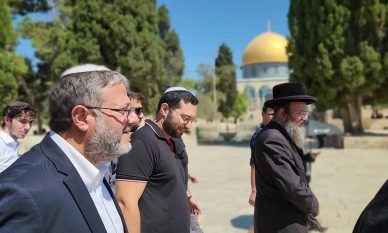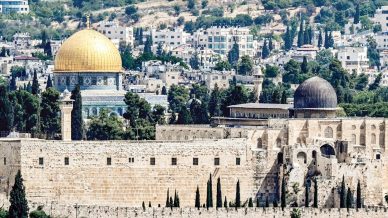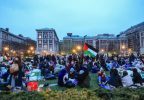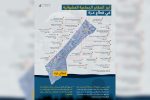The Salahaddin pulpit is named after Salah al-Din al-Ayyubi; however it was made at the instructions of Nur al-Din Zanki in 1168 AC to place it at Al-Aqsa Mosque after liberating it from the Crusaders.
This pulpit was made in Damascus by the most skilled craftsmen using wood decorated with ivory and ebony. It has a gate above which there is a crown and a staircase that leads to an arch with a wooden balcony with a total number of 12000 interlocking pieces of wood which made this pulpit an example of arts and beauty which also has Quranic and historical writings on it.
“The pulpit is the place where the Imam stands to give Friday sermons and to do religious preaching and it is located to the right of the prayer place of the Imam. It consists of a platform which is several steps high from the ground that Muslims paid a special attention to decorate with Quranic verses” said Ihab al-Jallad the author of the book “The Monuments of Al-Aqsa Mosque Under Focus.”
He said that the oldest historical mention of the pulpit of Al-Aqsa Mosque dates back to the Abbasid period. Ibn al-Faqih al-Hamdani (903 AD 290 AH) noted speaking of Al-Aqsa Mosque “there are four pulpits: one for preachers who are paid to preach while three are allocated for those who volunteer to do the job without being paid.” It seems that the old pulpits of the Mosque were destroyed during the Crusaders’ occupation of Jerusalem.
Noor al-Din’s pulpit during the Ayyubid period
Al-Jallad pointed out that after the Ayyubid liberation of Al-Aqsa Mosque Salahaddin ordered the construction of a pulpit for the liberation sermon. Then he was told about Noor al-Din’s pulpit thus he gave the instructions to bring it from Aleppo to the Al-Aqsa Mosque.
The carpenter who made the platform is known as Lakhatrini and he completed it in 10 years.
Description of the original pulpit
In his book Al-Jallad quoted scholar Ibn al-Atheer as saying “Noor al-Din Mahmud ordered building a pulpit in Aleppo urging craftsmen to pay extra attention to make it look perfect noting that the purpose behind building it was moving it to Al-Aqsa Mosque. Carpenters worked on it for several years and no other pulpit in the history of Islam looked like it.”
The pulpit was made of cedar wood ivory and ebony and it was distinguished by interconnecting its parts without using glue or nails.
The writings on the pulpit
Verses 90-93 of Surat Al-Nahl of the Holy Quran were engraved in parallel on the two sides of the pulpit and on the same side where the Imam sits where the word Allah appears inside a square the verse 18 of Surat Al-Tawbah was inscribed.
On the left side there is a parallel inscription that reads: “In the name of Allah Most Gracious Most Merciful. This pulpit was made at the instructions of the poor slave of Allah who needs his mercy and who is thankful for his grace the fighter in his path against the enemies of his religion the just king of Islam and Muslims Zanki ibn Aq Sinqar Nasser the commander of the faithful may Allah make his supporters in high positions and his enemies in low positions. May Allah keep his strength and light and may He spread in the world his flags. May Allah make more victories at his hands and make him blessed by witnessing victory. Amen.
Al-Jallad underlined that the pulpit remained at Al-Aqsa Mosque until the 21st of August 1969 serving as a witness to the liberation of Al-Aqsa yet the Israeli occupation sought to get rid of this symbol at the hands Australian Zionist Michael Rohan who started a big fire in the Mosque burning the historical pulpit.
A simple iron pulpit was made at Al-Aqsa in 2007 and it was replaced by a new pulpit similar to Noor al-Din’s and it was made of walnut (which is characterized by easy drilling and its oil that prevents insects from damaging the wood). The same verses engraved on Noor al-Din’s pulpit were engraved on the new pulpit.
Arab and Islamic efforts
This pulpit was rebuilt under the guidance and instructions of the late King Hussein of Jordan in 1993. His successor King Abdullah II put the decorative plaque for the pulpit in 2002 which is considered the first artistic work of its kind in modern history.
The great challenge faced by the craftsmen and engineers supervising this work was the collection of some 16500 pieces some of them were a few millimeters long only in a six-meter pulpit without the use of glue or screws. This is known as the art of pulpits by using interlocking to connect woods which consists of geometric decoration vegetal decoration calligraphy caving lathe ivory ebony and interlocking the main six elements that make Islamic arts.
The pulpit represents artistic and aesthetic art co-produced by artists from different countries of the Arab and Muslim worlds. Jordan insisted that the pulpit should be produced by artists from various Arab and Muslim countries for the pulpit to have the Arab and Muslim characteristics.















